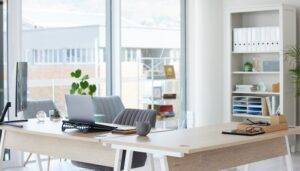
The modern workplace has undergone a significant transformation in recent years, with a focus on creating environments that foster creativity, collaboration, and productivity.
Central to this evolution is the design of office furniture, particularly office tables. Gone are the days of bland, uniform desks; today’s office table design are a blend of ergonomic functionality and contemporary aesthetics. In this article, we explore the evolution of office table design, highlighting key trends and innovations that have shaped the modern workspace.
Ergonomics: A Priority in Modern Office Table Design
One of the foremost considerations in contemporary office table design is ergonomics. Recognizing the impact of a well-designed workspace on employee health and productivity, manufacturers are now incorporating ergonomic principles into their designs. Adjustable height desks, for instance, allow users to customize the table height according to their preferences, promoting a healthier and more comfortable working posture. Additionally, features such as cable management systems and built-in power outlets contribute to a clutter-free and organized workspace.
Open and Collaborative Spaces
The traditional closed-off cubicle is becoming a thing of the past, making way for open and collaborative workspaces. Modern office table designs reflect this shift by incorporating features that facilitate communication and teamwork. Clustered workstations with shared tables are common, fostering a sense of community and encouraging spontaneous interactions among colleagues. Modular tables that can be easily reconfigured to accommodate different group sizes add a layer of flexibility to the modern office environment.
Minimalist Aesthetics
In the realm of office table design, less is often more. The minimalist aesthetic has gained popularity, characterized by clean lines, simple shapes, and a neutral color palette. Sleek, uncluttered tables contribute to a visually calming workspace, reducing distractions and promoting a focused atmosphere. This design approach also aligns with the growing trend of decluttering and simplifying work environments for enhanced productivity.
Versatility and Multi-functionality
Modern office tables are designed to serve multiple functions, catering to the diverse needs of a dynamic workplace. Some tables are equipped with built-in storage solutions, allowing users to keep essential items within arm’s reach. Others feature convertible designs, transforming from individual workstations to collaborative meeting spaces with ease. This versatility ensures that office furniture adapts to the evolving demands of the contemporary work environment.
Sustainable Materials and Design
As environmental consciousness grows, so does the emphasis on sustainable materials in office furniture design. Manufacturers are increasingly using recycled and eco-friendly materials in the production of office tables. Sustainable wood, bamboo, and recycled metal are popular choices, aligning with the broader corporate commitment to reducing the ecological footprint. Beyond materials, the design itself often prioritizes longevity and durability, contributing to a more sustainable approach to office furniture.
Technology Integration
In the era of smart offices, integrating technology into office table design is a natural progression. Many modern office tables come equipped with built-in charging ports, wireless charging pads, and USB outlets, catering to the ever-increasing reliance on electronic devices. Cable management systems are designed to keep wires organized and out of sight, contributing to a clean and streamlined workspace. This seamless integration of technology not only enhances functionality but also reflects the modern workforce’s tech-centric needs.
Personalization and Customization
Recognizing that individual preferences vary, modern table designs often incorporate elements of personalization and customization. Employees may have the option to choose from a variety of finishes, colors, and materials to create a workspace that aligns with their personal style. This not only enhances the aesthetic appeal of the office but also contributes to a sense of ownership and comfort for the individuals using the space.
Conclusion
The design of office tables has evolved significantly to meet the changing needs of the modern workplace. From prioritizing ergonomic principles and minimalist aesthetics to integrating technology and promoting sustainability, contemporary office tables are a reflection of the dynamic nature of work in the 21st century. As the workplace continues to evolve, so too will the design of office furniture, ensuring that it remains a key element in creating environments that foster productivity, collaboration, and employee well-being.
Read more:
Evolution of Modern Office Table Designs: Blending Functionality with Aesthetics





